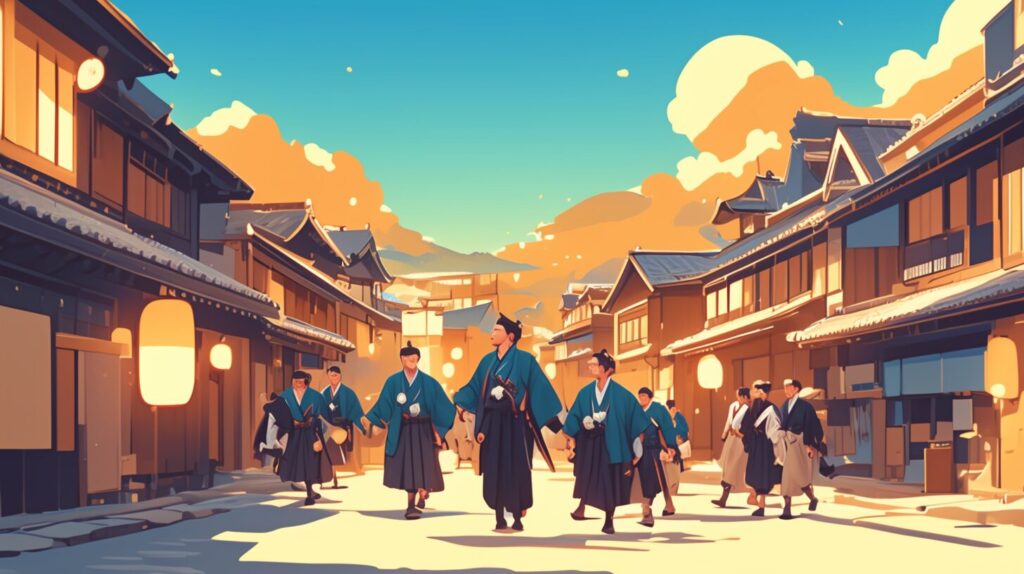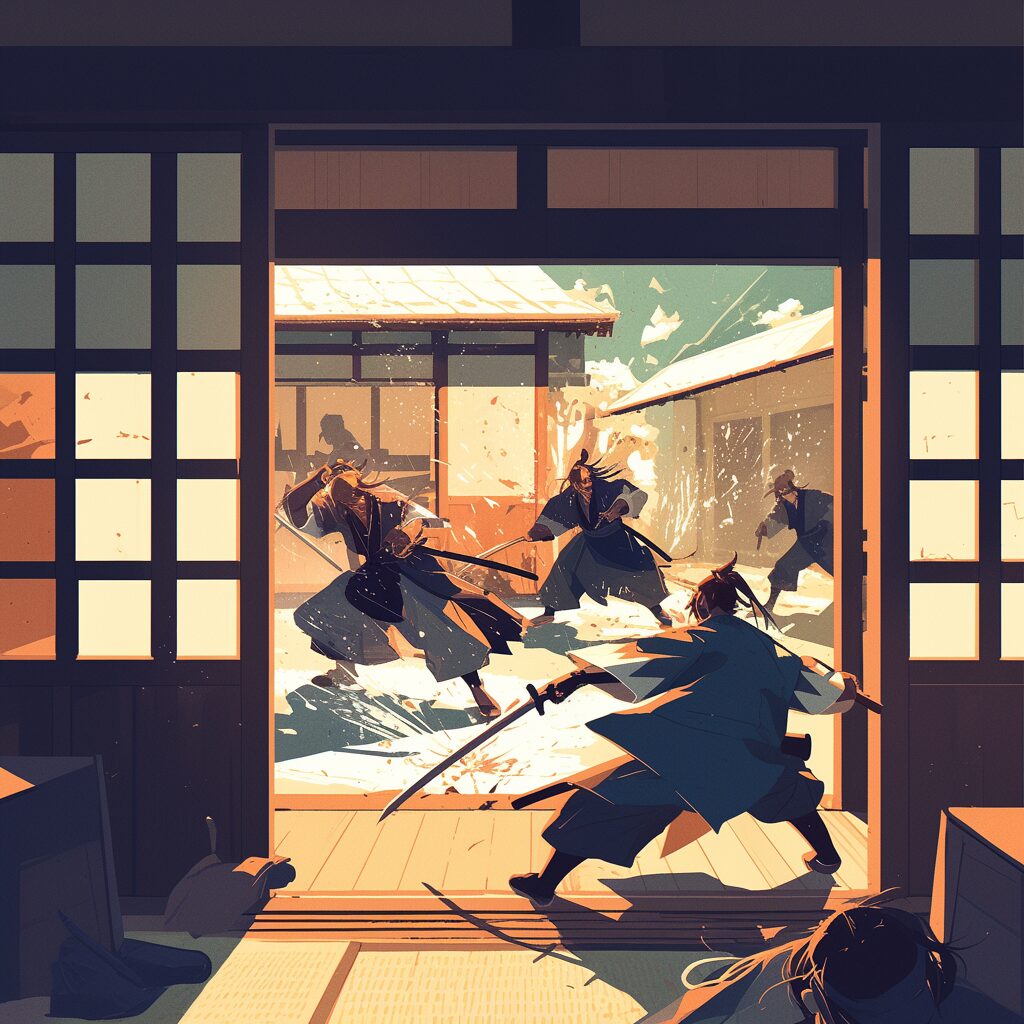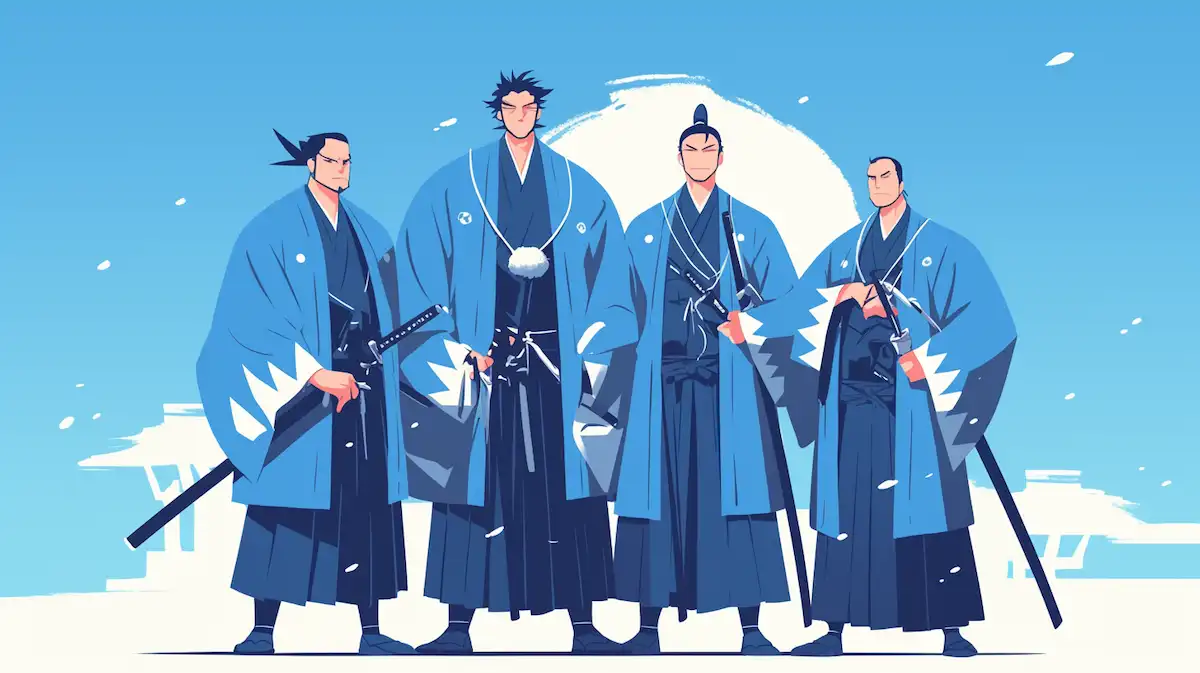新選組を英語で説明・紹介するための基本情報と、英会話に役立つ表現をシンプルでわかりやすい英語で紹介します。
英会話ダイアローグ・概要・10の質問を通して、新選組に関する英語表現を学びます。
英語
英会話ダイアローグを読む前に知っておくと良い前提知識と情報です。
- 新選組とは
- 幕末(19世紀後半)に活動した武装組織
- 1863年に京都で結成され、幕府のために治安維持を担うことを目的とした
- 幕府を守る武士(佐幕派)として、天皇側についた倒幕派(尊王攘夷派)と戦った
- 幕末の時代背景
- 19世紀後半、「幕府 vs 倒幕派」の内戦状態が進んでいた
- 徳川幕府(1603年~1868年)は、約260年間続いた政権、西洋の影響や国内の不満で弱体化
- 倒幕派(薩摩藩や長州藩)は、幕府を倒して、天皇中心の新しい政府を作ろうとしていた
- 新選組は、この激動の時代に、幕府側の戦士として活躍
- 新選組の結成と特徴
- もともとは「浪士組」という幕府が募集した警備隊
- リーダーの清河八郎が天皇側につこうとしたため、一部の浪士が京都に残り、新選組の前身となった
- 会津藩の保護のもと、「新選組」として正式に組織化
- 剣術の腕が優れた者が集まり、厳しい規律が敷かれた
- 特に、「裏切りや脱退は許されず、違反者は切腹」というルールが有名
- 主要メンバー
- 近藤勇 : 新選組の局長(リーダー)、農民出身だが、剣の腕とリーダーシップで組織を率いた
- 土方歳三 : 副長、「鬼の副長」と呼ばれるほど厳しい規律を作り、新選組を強くした
- 沖田総司 : 一番隊組長、天才剣士で、新選組最強の剣の使い手
- 斎藤一 : 三番隊組長、寡黙で冷静な剣士、後に警察官となった
- 永倉新八 : 二番隊組長、生き残り、後に新選組の記録を残した
- 池田屋事件(新選組の最大の功績)
- 1864年、倒幕派の志士たちが、京都に火を放ち、幕府の要人を暗殺する計画を立てていた
- これを察知した新選組は、池田屋という旅館を急襲し、計画を阻止
- この事件で新選組は幕府の信頼を得て、全国的に有名になった
- 幕府の崩壊と新選組の終焉
- 1868年、幕府が大政奉還を行い、戊辰戦争が勃発
- 新選組は幕府軍として戦うが、次々と敗北
- 近藤勇は1868年に処刑される
- 土方歳三は1869年、箱館(函館)戦争で戦死、これにより、新選組は事実上消滅
2人が新選組について話しています。
新選組の結成経緯、主要メンバーの活躍、池田屋事件、幕末期の動乱での彼らの最期までを話題にしています。
会話 / dialogue

Hey Key, I’ve been reading about the Shinsengumi lately. They seem like a really fascinating part of Japanese history.

Oh, really? Yeah, they’re one of the most famous samurai groups from the late Edo period. What got you interested in them?

I watched an anime that had characters based on the Shinsengumi. They seemed so cool and heroic, so I wanted to know more about the real history.

That makes sense. The Shinsengumi was formed in 1863 in Kyoto to protect the Tokugawa shogunate. Originally, they were part of a group called the Roshi-gumi, which was a samurai force recruited by the shogunate to maintain order.

Wait, so they weren’t just a group of random ronin (masterless samurai)?

No, not exactly. The Roshi-gumi was an official force, but their leader, Kiyokawa Hachiro, secretly supported the emperor instead of the shogunate. He tried to take them back to Edo, but a small group decided to stay in Kyoto under the protection of the Aizu domain. They later became the Shinsengumi.

That’s really interesting. So, who was in charge of the Shinsengumi?

Their leader was Kondo Isami. He was born into a farmer’s family but trained as a samurai and became the commander. His second-in-command was Hijikata Toshizo, a strict enforcer who made sure everyone followed the rules.

I heard he was called the “Demon Vice-Commander.” Was he really that strict?

Yes! He created the Shinsengumi’s rules, and anyone who betrayed or tried to leave had to commit seppuku (ritual suicide). This made the group highly disciplined and feared.

That sounds extreme, but I guess it helped keep them strong. Were they really good fighters?

Absolutely! Some of the best swordsmen in Japan were in the Shinsengumi. For example:
・Okita Soji – A genius swordsman, known for his deadly fast attacks.
・Saito Hajime – A silent but skilled fighter, who later became a police officer.
・Nagakura Shinpachi – A master swordsman who survived and wrote about their history.

Wow, they must have been really famous. Did they fight in any major battles?

Yes! Their most famous battle was the Ikedaya Incident in 1864.

What happened there?

A group of anti-shogunate samurai planned to burn Kyoto and assassinate important government officials. The Shinsengumi found out and attacked them at Ikedaya Inn, defeating them in a fierce battle.

So, after that, they became heroes, right?

Yes, but their reputation was complicated. Many people saw them as brave protectors, while others saw them as ruthless enforcers of the shogunate.

What happened when the shogunate collapsed?

In 1868, the Tokugawa shogunate fell, and the Boshin War began. The Shinsengumi fought for the shogunate, but they were defeated in many battles.

And Kondo Isami?

He was captured and executed in 1868. But Hijikata Toshizo refused to surrender and led the remaining members to Hokkaido for a final battle.

Did he survive?

No, he was killed in 1869 in the Battle of Hakodate. That was the end of the Shinsengumi.

That’s really tragic. But their story sounds so dramatic and inspiring. I can see why they’re still famous today.

Exactly! Their bravery, loyalty, and fighting spirit are legendary. That’s why they still appear in anime, movies, and games. If you’re interested, we should visit some historical sites related to them.

Great idea! Let’s go to Kyoto and see their old headquarters!
概要 / Overview
「新選組」について、理解を深めるための「英語での概要」です。
新選組

What Was the Shinsengumi?
The Shinsengumi was a samurai group that protected the Tokugawa shogunate during the late Edo period (19th century). They were formed in 1863 in Kyoto to maintain order and fight against anti-shogunate rebels. The group was known for its strict discipline, strong sword skills, and loyalty to the shogunate.
How Was the Shinsengumi Formed?
Originally, the Shinsengumi was part of the Roshi-gumi, a special group of samurai and ronin (masterless samurai) recruited by the shogunate. However, the leader of the Roshi-gumi, Kiyokawa Hachiro, secretly supported the emperor instead of the shogunate. When he tried to return to Edo, a small group stayed in Kyoto under the protection of the Aizu domain. This group later became the Shinsengumi.
Famous Leaders of the Shinsengumi
The Shinsengumi had many strong and famous leaders:
Kondo Isami : The commander, a former farmer who became a great samurai leader.
Hijikata Toshizo : The vice-commander, known as the “Demon Vice-Commander” because of his strict discipline.
Okita Soji : A young genius swordsman, famous for his fast and deadly attacks.
Saito Hajime : A silent but skilled fighter, who later became a police officer.
Nagakura Shinpachi : A strong swordsman, who survived and wrote about the Shinsengumi’s history.
The Ikedaya Incident (1864)
The Shinsengumi became famous after the Ikedaya Incident in 1864. A group of anti-shogunate samurai planned to burn Kyoto and assassinate government leaders. The Shinsengumi discovered the plan and attacked the rebels at Ikedaya Inn, defeating them in a fierce battle. This event made the Shinsengumi national heroes and increased their power.
The Fall of the Shinsengumi
In 1868, the Tokugawa shogunate collapsed, and the Boshin War began. The Shinsengumi fought for the shogunate but lost many battles. Kondo Isami was captured and executed in 1868, while Hijikata Toshizo continued fighting but was killed in 1869 during the Battle of Hakodate. After this, the Shinsengumi disappeared.
The Shinsengumi’s Legacy
Even today, the Shinsengumi is very popular in Japan. Their loyalty, bravery, and samurai spirit continue to inspire people. They appear in many movies, anime, and games, such as Rurouni Kenshin, Gintama, and Hakuouki. Many people visit historical sites in Kyoto and Hokkaido to learn more about them.
10の質問 / 10 questions
「新選組」について、理解を深めるための「英語での10の質問」です。
1: What is the Shinsengumi?
The Shinsengumi was a samurai group formed in 1863 to protect the Tokugawa shogunate in Kyoto. They were known for their strict discipline, strong sword skills, and loyalty to the shogunate.
2: Why was the Shinsengumi created?
The Tokugawa shogunate needed a special police force to maintain order in Kyoto and stop anti-shogunate rebels. The Shinsengumi was formed to serve this purpose.
3: Who was the leader of the Shinsengumi?
Kondo Isami was the leader of the Shinsengumi. He was born into a farmer’s family but trained as a samurai and became the commander.
4: What was Hijikata Toshizo’s role in the Shinsengumi?
Hijikata Toshizo was the vice-commander. He was strict and created the Shinsengumi’s rules. Because of his discipline, he was called the “Demon Vice-Commander.”
5: What was the Ikedaya Incident?
The Ikedaya Incident happened in 1864. A group of anti-shogunate samurai planned to burn Kyoto, but the Shinsengumi attacked them at Ikedaya Inn and stopped the plan.
6: What happened to the Shinsengumi after the shogunate collapsed?
When the Tokugawa shogunate fell in 1868, the Shinsengumi continued fighting for the old government but lost many battles in the Boshin War.
7: What was the fate of Kondo Isami?
Kondo Isami was captured by the new government and executed in 1868. His death marked the decline of the Shinsengumi.
8: Did Hijikata Toshizo survive?
No, Hijikata Toshizo continued fighting but was killed in 1869 during the Battle of Hakodate, the last battle of the Boshin War.
9: Why is the Shinsengumi still popular today?
The Shinsengumi is famous for its samurai spirit, loyalty, and tragic story. They appear in anime, movies, and games, making them popular even now.
10: Where can people learn more about the Shinsengumi?
People can visit historical sites in Kyoto, like Mibudera Temple, or go to Hakodate, where the last battle took place. Many museums also have Shinsengumi exhibits.

和訳付
会話 / dialogue

Hey Key, I’ve been reading about the Shinsengumi lately. They seem like a really fascinating part of Japanese history.
最近新選組について読んでるんだけど、本当に興味深い歴史の一部だよね。

Oh, really? Yeah, they’re one of the most famous samurai groups from the late Edo period. What got you interested in them?
そうなの?うん、新選組は幕末の侍集団の中でも特に有名だよ。どうして興味を持ったの?

I watched an anime that had characters based on the Shinsengumi. They seemed so cool and heroic, so I wanted to know more about the real history.
新選組をモチーフにしたキャラクターが出てくるアニメを見たんだ。彼らがかっこよくて英雄的に見えて、実際の歴史をもっと知りたくなったんだよ。

That makes sense. The Shinsengumi was formed in 1863 in Kyoto to protect the Tokugawa shogunate. Originally, they were part of a group called the Roshi-gumi, which was a samurai force recruited by the shogunate to maintain order.
それは分かるよ。新選組は1863年に京都で結成されて、徳川幕府を守るために作られたんだ。もともとは浪士組という、幕府が治安維持のために召集した武士集団の一部だったんだよ。

Wait, so they weren’t just a group of random ronin (masterless samurai)?
え、それじゃあ彼らはただの浪人(主君のいない侍)の集まりじゃなかったの?

No, not exactly. The Roshi-gumi was an official force, but their leader, Kiyokawa Hachiro, secretly supported the emperor instead of the shogunate. He tried to take them back to Edo, but a small group decided to stay in Kyoto under the protection of the Aizu domain. They later became the Shinsengumi.
いや、ちょっと違うね。浪士組は幕府の正式な組織だったけど、リーダーの清河八郎は実は幕府じゃなくて天皇を支持していたんだ。それで彼は浪士組を江戸に戻そうとしたんだけど、一部のメンバーが会津藩の保護のもと、京都に残ることを決意したんだ。それが後の新選組になったんだよ。

That’s really interesting. So, who was in charge of the Shinsengumi?
それは面白いね。じゃあ、新選組のリーダーは誰だったの?

Their leader was Kondo Isami. He was born into a farmer’s family but trained as a samurai and became the commander. His second-in-command was Hijikata Toshizo, a strict enforcer who made sure everyone followed the rules.
リーダーは近藤勇だったよ。彼は農家の家に生まれたけど、武士としての訓練を受けて、最終的に局長(リーダー)になったんだ。彼の副長(No.2)は土方歳三で、規律を徹底させる厳格な指導者だったよ。

I heard he was called the “Demon Vice-Commander.” Was he really that strict?
「鬼の副長」って呼ばれてたって聞いたことあるけど、そんなに厳しかったの?

Yes! He created the Shinsengumi’s rules, and anyone who betrayed or tried to leave had to commit seppuku (ritual suicide). This made the group highly disciplined and feared.
そうだよ!彼が新選組の規則を作って、もし裏切ったり、脱退しようとしたりしたら、切腹しなきゃならなかったんだ。この厳しい規律のおかげで、新選組は恐れられ、引き締まった組織になったんだよ。

That sounds extreme, but I guess it helped keep them strong. Were they really good fighters?
それはかなり厳しいね。でも、強さを保つには必要だったのかも。彼らは本当に強かったの?

Absolutely! Some of the best swordsmen in Japan were in the Shinsengumi. For example:
・Okita Soji – A genius swordsman, known for his deadly fast attacks.
・Saito Hajime – A silent but skilled fighter, who later became a police officer.
・Nagakura Shinpachi – A master swordsman who survived and wrote about their history.
もちろん!新選組には、日本でも最高レベルの剣士がいたんだ。例えば:
・沖田総司 : 天才剣士で、超高速の突き技が有名だった。
・斎藤一 : 無口だけど強い戦士で、後に警察官になった。
・永倉新八 : 剣の達人で、生き延びて新選組の歴史を書き残した。

Wow, they must have been really famous. Did they fight in any major battles?
すごいな、彼らは相当有名だったんじゃない?何か大きな戦いに参加したの?

Yes! Their most famous battle was the Ikedaya Incident in 1864.
うん!彼らの最も有名な戦いは1864年の池田屋事件だよ。

What happened there?
それはどんな事件だったの?

A group of anti-shogunate samurai planned to burn Kyoto and assassinate important government officials. The Shinsengumi found out and attacked them at Ikedaya Inn, defeating them in a fierce battle.
倒幕派の志士たちが、京都に火を放ち、幕府の重要人物を暗殺する計画を立てていたんだ。それを新選組が事前に察知し、池田屋で彼らを急襲して、激しい戦いの末に勝利したんだよ。

So, after that, they became heroes, right?
それで、新選組は英雄になったんだよね?

Yes, but their reputation was complicated. Many people saw them as brave protectors, while others saw them as ruthless enforcers of the shogunate.
そうなんだけど、彼らの評判は複雑だったんだ。一部の人々は勇敢な守護者と見なしたけど、別の人々は幕府の冷酷な取り締まり役と見ていたんだよ。

What happened when the shogunate collapsed?
幕府が倒れた時、新選組はどうなったの?

In 1868, the Tokugawa shogunate fell, and the Boshin War began. The Shinsengumi fought for the shogunate, but they were defeated in many battles.
1868年に幕府が崩壊して、戊辰戦争が始まったんだ。新選組は幕府側について戦ったけど、多くの戦いで敗北してしまった。

And Kondo Isami?
それで、近藤勇はどうなったの?

He was captured and executed in 1868. But Hijikata Toshizo refused to surrender and led the remaining members to Hokkaido for a final battle.
彼は1868年に捕らえられて処刑されたよ。でも、土方歳三は降伏を拒み、残った隊士を率いて北海道へ行き、最後の戦いに挑んだんだ。

Did he survive?
土方は生き延びたの?

No, he was killed in 1869 in the Battle of Hakodate. That was the end of the Shinsengumi.
いや、1869年の箱館戦争で戦死したよ。それが新選組の終わりだったんだ。

That’s really tragic. But their story sounds so dramatic and inspiring. I can see why they’re still famous today.
それは本当に悲しいな。でも、彼らの物語はすごくドラマチックで心を打つね。今でも有名なのがよく分かるよ。

Exactly! Their bravery, loyalty, and fighting spirit are legendary. That’s why they still appear in anime, movies, and games. If you’re interested, we should visit some historical sites related to them.
そうなんだよ!彼らの勇気、忠誠心、そして戦う精神は伝説になっているからね。だから今でもアニメや映画、ゲームに登場するんだ。もし興味があるなら、新選組ゆかりの地を巡ってみようよ!

Great idea! Let’s go to Kyoto and see their old headquarters!
いいね!じゃあ、京都に行って彼らの本拠地を見に行こう!
概要 / Overview
新選組

What Was the Shinsengumi?
The Shinsengumi was a samurai group that protected the Tokugawa shogunate during the late Edo period (19th century). They were formed in 1863 in Kyoto to maintain order and fight against anti-shogunate rebels. The group was known for its strict discipline, strong sword skills, and loyalty to the shogunate.
新選組とは?
新選組は、幕末(19世紀)に徳川幕府を守るために活動した侍の集団です。1863年に京都で結成され、治安維持と反幕府勢力との戦いを目的としていました。彼らは厳しい規律、強い剣術の腕前、そして幕府への忠誠心で知られていました。
How Was the Shinsengumi Formed?
Originally, the Shinsengumi was part of the Roshi-gumi, a special group of samurai and ronin (masterless samurai) recruited by the shogunate. However, the leader of the Roshi-gumi, Kiyokawa Hachiro, secretly supported the emperor instead of the shogunate. When he tried to return to Edo, a small group stayed in Kyoto under the protection of the Aizu domain. This group later became the Shinsengumi.
新選組の結成
もともと新選組は、幕府が募集した浪士組という特別な武士集団の一部でした。しかし、浪士組のリーダーである清河八郎は、実は幕府ではなく天皇を支持していたのです。彼が浪士組を江戸に戻そうとしたとき、一部のメンバーが会津藩の保護のもと、京都に残ることを決意しました。このグループが後に新選組となりました。
Famous Leaders of the Shinsengumi
The Shinsengumi had many strong and famous leaders:
Kondo Isami : The commander, a former farmer who became a great samurai leader.
Hijikata Toshizo : The vice-commander, known as the “Demon Vice-Commander” because of his strict discipline.
Okita Soji : A young genius swordsman, famous for his fast and deadly attacks.
Saito Hajime : A silent but skilled fighter, who later became a police officer.
Nagakura Shinpachi : A strong swordsman, who survived and wrote about the Shinsengumi’s history.
新選組の有名なリーダー
新選組には、多くの優れたリーダーがいました。
近藤勇: 局長で、もとは農民の出身でしたが、優れた侍の指導者となりました。
土方歳三: 副長で、「鬼の副長」と呼ばれるほど厳格な規律を持っていました。
沖田総司: 若き天才剣士で、超高速の剣技で有名でした。
斎藤一: 無口だが優れた剣士で、後に警察官になりました。
永倉新八: 剣の名手で、生き延びて新選組の歴史を記録に残しました。
The Ikedaya Incident (1864)
The Shinsengumi became famous after the Ikedaya Incident in 1864. A group of anti-shogunate samurai planned to burn Kyoto and assassinate government leaders. The Shinsengumi discovered the plan and attacked the rebels at Ikedaya Inn, defeating them in a fierce battle. This event made the Shinsengumi national heroes and increased their power.
池田屋事件(1864年)
新選組は、1864年の池田屋事件で一躍有名になりました。倒幕派の志士たちが京都に火を放ち、幕府の要人を暗殺する計画を立てていました。これを察知した新選組は、池田屋という旅館を急襲し、激しい戦闘の末に彼らを打ち破ったのです。この事件により、新選組は全国的な英雄となり、その影響力をさらに強めました。
The Fall of the Shinsengumi
In 1868, the Tokugawa shogunate collapsed, and the Boshin War began. The Shinsengumi fought for the shogunate but lost many battles. Kondo Isami was captured and executed in 1868, while Hijikata Toshizo continued fighting but was killed in 1869 during the Battle of Hakodate. After this, the Shinsengumi disappeared.
新選組の終焉
1868年、徳川幕府が崩壊し、戊辰戦争が始まりました。新選組は幕府側として戦いましたが、多くの戦闘で敗北しました。近藤勇は1868年に捕らえられ、処刑されましたが、土方歳三は降伏せず、最後まで戦いました。しかし、1869年の箱館戦争で戦死し、新選組はその後消滅しました。
The Shinsengumi’s Legacy
Even today, the Shinsengumi is very popular in Japan. Their loyalty, bravery, and samurai spirit continue to inspire people. They appear in many movies, anime, and games, such as Rurouni Kenshin, Gintama, and Hakuouki. Many people visit historical sites in Kyoto and Hokkaido to learn more about them.
新選組の遺産と影響
新選組は現在でも非常に人気のある歴史的な侍集団です。彼らの忠誠心、勇敢さ、侍の精神は、今も多くの人々に影響を与えています。るろうに剣心、銀魂、薄桜鬼のようなアニメ、映画、ゲームにも登場し、多くのファンを持っています。京都や函館の新選組ゆかりの地を訪れる人も多く、彼らの歴史を学び続けています。
10の質問 / 10 questions
1: What is the Shinsengumi?
新選組とは何ですか?
The Shinsengumi was a samurai group formed in 1863 to protect the Tokugawa shogunate in Kyoto. They were known for their strict discipline, strong sword skills, and loyalty to the shogunate.
新選組は、1863年に京都で結成された侍の集団で、徳川幕府を守るために活動しました。彼らは厳しい規律、優れた剣術、そして幕府への忠誠心で知られていました。
2: Why was the Shinsengumi created?
新選組はなぜ作られたのですか?
The Tokugawa shogunate needed a special police force to maintain order in Kyoto and stop anti-shogunate rebels. The Shinsengumi was formed to serve this purpose.
徳川幕府は、京都の治安を維持し、反幕府勢力を取り締まるための特別な警備隊を必要としていました。そのため、新選組が結成されました。
3: Who was the leader of the Shinsengumi?
新選組のリーダーは誰ですか?
A: Kondo Isami was the leader of the Shinsengumi. He was born into a farmer’s family but trained as a samurai and became the commander.
新選組のリーダーは近藤勇でした。彼は農家の出身でしたが、武士としての訓練を受け、最終的に隊長となりました。
4: What was Hijikata Toshizo’s role in the Shinsengumi?
土方歳三の新選組での役割は何でしたか?
Hijikata Toshizo was the vice-commander. He was strict and created the Shinsengumi’s rules. Because of his discipline, he was called the “Demon Vice-Commander.”
土方歳三は副長でした。彼は非常に厳しく、新選組の規則を作りました。その規律の厳しさから、「鬼の副長」と呼ばれました。
5: What was the Ikedaya Incident?
池田屋事件とは何ですか?
The Ikedaya Incident happened in 1864. A group of anti-shogunate samurai planned to burn Kyoto, but the Shinsengumi attacked them at Ikedaya Inn and stopped the plan.
池田屋事件は1864年に起こりました。倒幕派の侍たちが京都を焼き払おうと計画しましたが、新選組が池田屋という旅館で彼らを襲撃し、計画を阻止しました。
6: What happened to the Shinsengumi after the shogunate collapsed?
幕府が崩壊した後、新選組はどうなりましたか?
When the Tokugawa shogunate fell in 1868, the Shinsengumi continued fighting for the old government but lost many battles in the Boshin War.
1868年に徳川幕府が崩壊した後も、新選組は旧幕府のために戦い続けましたが、戊辰戦争で多くの戦いに敗れました。
7: What was the fate of Kondo Isami?
近藤勇の運命はどうなりましたか?
Kondo Isami was captured by the new government and executed in 1868. His death marked the decline of the Shinsengumi.
近藤勇は新政府軍に捕らえられ、1868年に処刑されました。彼の死は新選組の衰退を象徴する出来事でした。
8: Did Hijikata Toshizo survive?
土方歳三は生き延びましたか?
No, Hijikata Toshizo continued fighting but was killed in 1869 during the Battle of Hakodate, the last battle of the Boshin War.
いいえ、土方歳三は戦い続けましたが、戊辰戦争の最後の戦いである1869年の箱館戦争で戦死しました。
9: Why is the Shinsengumi still popular today?
なぜ新選組は今でも人気があるのですか?
The Shinsengumi is famous for its samurai spirit, loyalty, and tragic story. They appear in anime, movies, and games, making them popular even now.
新選組は、侍の精神、忠誠心、そして悲劇的な物語で有名です。アニメ、映画、ゲームなどに登場し、現在でも人気があります。
10: Where can people learn more about the Shinsengumi?
新選組についてもっと学ぶにはどこに行けばいいですか?
People can visit historical sites in Kyoto, like Mibudera Temple, or go to Hakodate, where the last battle took place. Many museums also have Shinsengumi exhibits.
京都の壬生寺などの歴史的な場所を訪れたり、新選組の最後の戦いがあった函館に行ったりすることができます。多くの博物館でも新選組に関する展示が行われています。

words & phrases
英会話ダイアローグと関連情報に出てきた単語・フレーズです(例文は各3つ)。

commander : 名詞
意味: 指揮官、司令官。A person in charge of a group of soldiers or military unit.
(新選組のリーダーである近藤勇を指す)
例文:
- The commander led his troops into battle.
「指揮官は部隊を率いて戦場に向かった。」 - Kondo Isami was the commander of the Shinsengumi.
「近藤勇は新選組の局長だった。」 - The commander gave the order to attack.
「司令官は攻撃命令を出した。」
betray : 動詞
意味: 裏切る、秘密を漏らす。To be disloyal to someone or reveal a secret.
(浪士組のリーダー、清河八郎が幕府を裏切ったことを指す)
例文:
- He would never betray his friends.
「彼は決して友人を裏切らない。」 - Kiyokawa Hachiro betrayed the shogunate by supporting the emperor.
「清河八郎は天皇を支持し、幕府を裏切った。」 - The spy betrayed his country.
「そのスパイは祖国を裏切った。」
swordsman : 名詞
意味: 剣士、剣の使い手。A person skilled in sword fighting.
(新選組の剣の名手である沖田総司や斎藤一を指す)
例文:
- He trained for years to become a great swordsman.
「彼は偉大な剣士になるために何年も修行した。」 - Okita Soji was a swordsman known for his speed.
「沖田総司はその速さで知られる剣士だった。」 - The samurai was the best swordsman in the region.
「その侍は地域で最も優れた剣士だった。」
assassinate : 動詞
意味: 暗殺する。To kill someone, usually a political or important figure.
(新選組の最初のリーダーの一人、芹沢鴨が暗殺されたことを指す)
例文:
- The king was assassinated by his enemies.
「王は敵に暗殺された。」 - Serizawa Kamo was assassinated by his own men.
「芹沢鴨は部下によって暗殺された。」 - Many historical leaders were assassinated for political reasons.
「多くの歴史的指導者が政治的理由で暗殺された。」
surrender : 動詞
意味: 降伏する、降参する。To stop fighting and accept defeat.
(土方歳三が幕府のために最後まで戦い、降伏せずに戦死したことを指す)
例文:
- The army surrendered after losing the battle.
「その軍隊は戦いに敗れて降伏した。」 - Hijikata Toshizo refused to surrender and fought until the end.
「土方歳三は降伏を拒み、最後まで戦った。」 - The soldiers had no choice but to surrender.
「兵士たちは降伏するしかなかった。」
